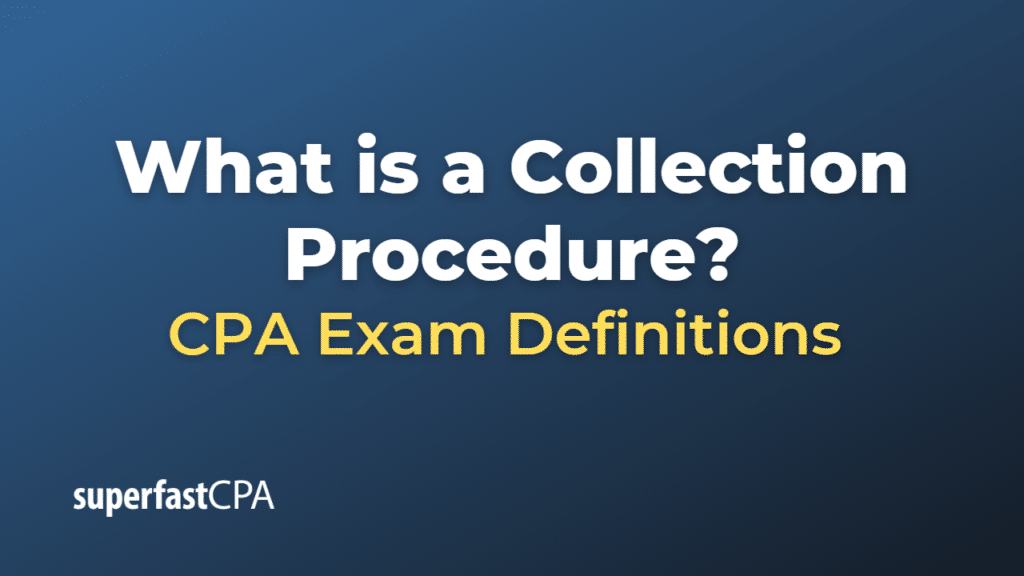Collection Procedure
A collection procedure is a systematic process that a business follows to collect outstanding payments from its customers who have purchased goods or services on credit terms. The main goal of a collection procedure is to recover outstanding debts in a timely, efficient, and legally compliant manner, while also maintaining positive customer relationships.
An effective collection procedure typically includes the following steps:
- Credit assessment: Before extending credit to customers, a business should conduct a credit assessment to evaluate the creditworthiness of the customer and determine the appropriate credit terms, such as payment deadlines and credit limits.
- Invoicing: The business should issue accurate and clear invoices to customers, specifying the payment terms, due dates, and the necessary payment details.
- Payment reminders: As the payment due date approaches or immediately after it has passed, the business may send payment reminders to customers through email, phone calls, or letters, reminding them of their outstanding balance and encouraging prompt payment.
- Follow-up and escalation: If the customer does not respond to payment reminders or fails to make the payment, the business may escalate its collection efforts by increasing the frequency of communication or involving higher-level management in the process.
- Payment arrangements: In some cases, the business may negotiate payment arrangements with the customer, such as partial payments or extended payment plans, to facilitate debt recovery.
- Legal action: If all previous steps have been unsuccessful in recovering the outstanding debt, the business may consider taking legal action, such as filing a lawsuit or engaging a collection agency, to recover the debt. This step should be considered as a last resort, as it can be costly and potentially harm the customer relationship.
- Bad debt write-off: If the debt is deemed uncollectible after exhausting all collection efforts, the business may decide to write off the debt as a bad debt expense in its financial statements.
An efficient and well-documented collection procedure not only helps a business to recover outstanding debts and maintain healthy cash flow but also ensures compliance with relevant regulations and minimizes the risk of disputes or litigation.
Example of a Collection Procedure
Let’s consider a hypothetical example of a collection procedure for a company called “ABC Furnishings,” which sells furniture on credit terms to its customers.
- Credit assessment: Before extending credit to a new customer, ABC Furnishings conducts a thorough credit assessment by reviewing the customer’s credit history, financial statements, and payment patterns with other suppliers. Based on the assessment, the company assigns a credit limit and payment terms (e.g., net 30 days) for the customer.
- Invoicing: After a sale, ABC Furnishings issues a clear and accurate invoice to the customer, specifying the payment due date, payment options, and contact details for any payment-related inquiries.
- Payment reminders: A week before the payment due date, ABC Furnishings sends an email reminder to the customer, gently reminding them of the upcoming due date and providing the necessary payment information.
- Follow-up and escalation: If the payment is not received by the due date, ABC Furnishings calls the customer to inquire about the overdue payment and offers assistance in resolving any potential issues. If the payment remains outstanding after several follow-up attempts, the company escalates the matter to higher-level management.
- Payment arrangements: If the customer is facing financial difficulties, ABC Furnishings may negotiate a payment arrangement, such as a partial payment plan or an extended payment deadline, to facilitate debt recovery.
- Legal action: If all previous efforts have been unsuccessful, ABC Furnishings may decide to engage a collection agency or consider taking legal action to recover the outstanding debt.
- Bad debt write-off: After exhausting all collection efforts, if the debt is deemed uncollectible, ABC Furnishings writes off the outstanding amount as a bad debt expense in its financial statements.
By following this structured collection procedure, ABC Furnishings can improve its chances of recovering outstanding debts in a timely manner, maintain healthy cash flow, and ensure compliance with relevant regulations.













